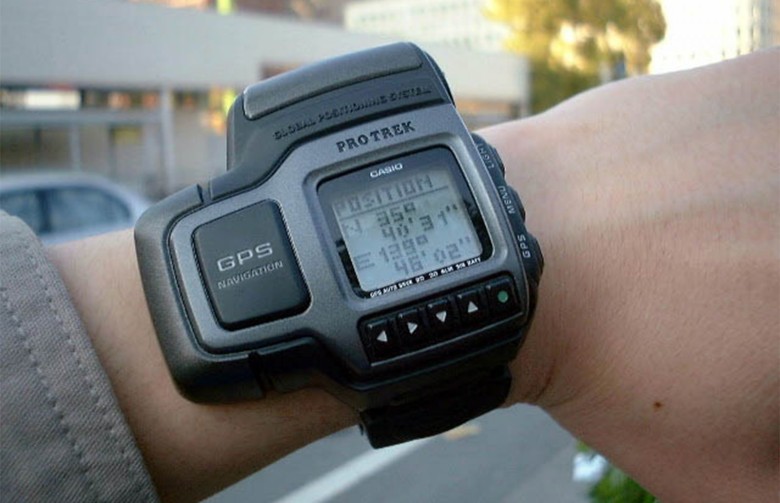Casio GPS
Casio is one of many companies that have moved their GPS operations to Android OS smartwatches. Years before making this decision, though, Casio broke ground on GPS wristwatch innovation. In fact, their Pro-Trek series premiered a model nicknamed the “Satellite Navi” in 1999—which was the first wristwatch with built-in GPS on the market. Casio had already been familiar with stretching the ability of digital watches to perform functions outside of timekeeping, up to that point. It could be said that between Casio and Seiko the era of smartwatches started as far back as the 1980s. With computation getting smaller and smaller over the years the adaptability of multiple technologies into one package became easier and easier. But before everyone had access to, essentially, whole computers on their wrists—the weeds had to be sifted through to find watch features that matched various lifestyles. This is what was so impressive about the 1999 release of the Satellite Navi. It encouraged forward thinking in terms of how watches could ease the burden of tracking travel across time.
The First Built-In GPS Watch

The Casio PRT-1GPJ (Satellite Navi) premiered at the Consumer Electronics Show (CES) in Las Vegas, January ‘99. Its premiere was well received, so much so that the watch went into full production and was released to consumers in June of that year. The general specifications included a ten hour battery (at full charge), receiving information from 27 US satellites (a far cry from the hundreds that are up there now), and displaying a very basic map of the wearer’s location. When we say basic we mean 8-bit digitized mapping. It was a crude way to deal with global positioning but it was ahead of its time in vision.
Although by today’s standards it’s a clunky device—having a massive case size standing almost an inch off the wearer’s wrist—Casio delivered on bringing GPS computation down to a personal level. In all honesty, GPS watches haven’t come incredibly far from this original tech, but there have been improvements. Newer models, along with smartwatch designs on the market, have brought the size of wrist-worn GPS down considerably. As well, satellite mapping has become much more accurate and battery lives last a little bit longer—depending on the piece. That being said, the biggest improvements have come in making the package more wearable and easy to read (10hrs is still a pretty hefty battery life by today’s rechargeability standards).
Original Smartwatches
Casio and other digital watch manufacturers were the progenitors of an era of watches that pushed watches far beyond simple timekeeping. During the Quartz Revolution/Crisis Japanese watchmakers began incorporating vogue elements of technology into wristwatches. Critics of this style of watchmaking are quick to point out the relative novelty of certain “techy” watches. However, as novel as some inventions may be or have been, their inspiration comes from believing in the engineering prowess of people to illuminate and inspire new ideas in watchmaking. Thus we’ll likely be covering more proto-smartwatches, like the Casio Satellite Navi, here in our blog in the near future. After all, the future itself draws just as much from the past as it does the present—in terms of how the watch world influences its own creations.
Times Ticking has been in operation for more than 30 years, since 1982. We have performed watch repair for customers both locally and internationally. If it Ticks! We KNOW it! Our team of watch repair technicians have a combined experience in watchmaking of over 120 years.

